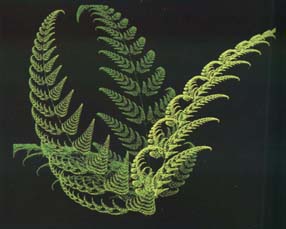
|
|
|
Fractal Geometry is based on the idea of scale invariance which means that a figure is the same, or is invariant, no matter on what scale it is observed. In other words, the figure is constructed by repeating the same pattern at smaller and smaller scales. The fern is certainly one of the best examples for understanding this idea: a small part of the figure when enlarged reproduces the original figure (or if you will, the part contains the whole). An object which possesses this property is called a fractal. From a mathematical point of view, the repetition of patterns at smaller and smaller scales can be continued to infinity. In the real word, nevertheless, the repetition stops after a certain number of jumps.
A fractal construction is extremely interesting for reasons of effectiveness. For example, if one wants to insert the largest sheet possible in the smallest possible volume, by folding it up in such a way that its faces never touch, one must give it a fractal shape. In addition, the instructions for such a folding are very simple (and can be written in very few words) since it suffices to state that the same folding pattern is repeated many times in succession. This is surely why one finds many fractal objects in nature: the instructions for their growth can be encoded in very little space in DNA.
This auto-repetition of the same structure can also be applied to phenomena which vary in time. For example, the fluctuations of the stock market possess a statistical fractal structure, that is to say, the fluctuations over a year are similar on the average to those over a month, or to those over a day, or even to those over an hour. To put it another way, if one "enlarges" the fluctuations over one day, one obtains fluctuations which could very well be those over a year. Note, however, this is not always true.
Let's take for example the saw : if one selects a small portion of the blade of the saw (a tooth) and then enlarge it, one does not obtain a new saw at all but only a very big tooth! In other words, on theblade of a saw, there are not teeth on teeth on teeth, etc.
Even if in certain cases the scale invariance is only statistical (stock market fluctuations, coastlines, clouds), it is nevertheless rigorously defined with what is called the fractal dimension, which measures in a way the degree of "roughness" of the fluctuations or of the boundaries of the object.
For further discussion, go to the Fractals section in the Sculpture Maths section.
REFERENCE:
Michael Barnsley, Fractals Everywhere, Academic Press Professional, 1988.
© Mathematics and Knots, U.C.N.W.,Bangor, 1996 - 2002
This material may be used freely for educational, artistic and
scientific purposes, but may not be used for commercial purposes,
for profit or in texts without the permission of the publishers.